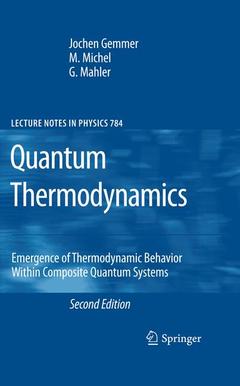Description
Quantum Thermodynamics (2nd Ed., Softcover reprint of hardcover 2nd ed. 2010)
Emergence of Thermodynamic Behavior Within Composite Quantum Systems
Lecture Notes in Physics Series, Vol. 784
Authors: Gemmer Jochen, Michel M., Mahler Günter
Language: English
84.39 €
In Print (Delivery period: 15 days).
Add to cart
Quantum Thermodynamics (2nd Ed.)
Publication date: 03-2012
346 p. · 15.5x23.5 cm · Paperback
Publication date: 03-2012
346 p. · 15.5x23.5 cm · Paperback
84.39 €
Subject to availability at the publisher.
Add to cart
Quantum thermodynamics: Emergence of thermodynamic behavior within composite systems (Lecture notes in physics, Vol. 784) (2nd Ed.)
Publication date: 10-2009
346 p. · 15.5x23.5 cm · Hardback
Publication date: 10-2009
346 p. · 15.5x23.5 cm · Hardback
Description
/li>Contents
/li>Comment
/li>
Over the years enormous effort was invested in proving ergodicity, but for a number of reasons, con?dence in the fruitfulness of this approach has waned. ? Y. Ben-Menahem and I. Pitowsky [1] Abstract The basic motivation behind the present text is threefold: To give a new explanation for the emergence of thermodynamics, to investigate the interplay between quantum mechanics and thermodynamics, and to explore possible ext- sions of the common validity range of thermodynamics. Originally, thermodynamics has been a purely phenomenological science. Early s- entists (Galileo, Santorio, Celsius, Fahrenheit) tried to give de?nitions for quantities which were intuitively obvious to the observer, like pressure or temperature, and studied their interconnections. The idea that these phenomena might be linked to other ?elds of physics, like classical mechanics, e.g., was not common in those days. Such a connection was basically introduced when Joule calculated the heat equ- alent in 1840 showing that heat was a form of energy, just like kinetic or potential energy in the theory of mechanics. At the end of the 19th century, when the atomic theory became popular, researchers began to think of a gas as a huge amount of bouncing balls inside a box.
Background.- Basics of Quantum Mechanics.- Basics of Thermodynamics and Statistics.- Brief Review of Pertinent Concepts.- Equilibrium.- The Program for the Foundation of Thermodynamics.- Outline of the Present Approach.- Dynamics and Averages in Hilbert Space.- Typicality of Observables and States.- System and Environment.- The Typical Reduced State of the System.- Entanglement, Correlations and Local Entropy.- Generic Spectra of Large Systems.- Temperature.- Pressure and Adiabatic Processes.- Quantum Mechanical and Classical State Densities.- Equilibration in Model Systems.- Non-Equilibrium.- Brief Review of Relaxation and Transport Theories.- Projection Operator Techniques and Hilbert Space Average Method.- Finite Systems as Thermostats.- Projective Approach to Dynamical Transport.- Open System Approach to Transport.- Applications and Models.- Purity and Local Entropy in Product Hilbert Space.- Observability of Intensive Variables.- Observability of Extensive Variables.- Quantum Thermodynamic Processes.
Includes supplementary material: sn.pub/extras
© 2024 LAVOISIER S.A.S.




